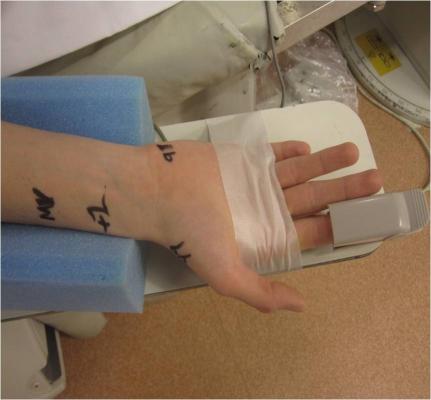
Transradial coronary artery angiography was a major focus at the Society for Cardiovascular Angiography Interventions (SCAI) 2013 Scientific Sessions May 8-11 in Orlando, Fla. The meeting kicked-off with a dedicated symposium covering topics such as access, radiation exposure and complications. While adoption of radial artery access in the United States has still been slower than in other areas of the world, interest and excitement continue to grow. Both faculty and attendees noted that increasing pressures for decreased cost and increased safety are strengthening the case for the radial artery approach as the access site of choice for many patients.
Obtaining Access
Ian Gilchrist, M.D., FSCAI, from the Penn State Hershey Heart and Vascular Institute, Hershey, Penn., discussed the use of ultrasound in obtaining radial artery access. Ultrasound, which is being used increasingly in central line access, has rarely been the tool selected for radial access. While it does add about six minutes of time to the procedure, utilization of ultrasound may improve procedural success and reduce femoral access crossover rates. In fact, in recent data from Roberts et al, ultrasound improved first stick success from the 20-40 percent range up to the 80 percent range, while reducing time for access.
In a discussion of radial artery occlusion, management and prevention, Sunil Rao, M.D., FSCAI, Duke University division of cardiology, Durham, N.C., pointed out the strong association between radial artery flow at the end of a procedure and both short- and long-term patency. New techniques in non-occlusive hemostasis tend to preserve long-term patency, and recovery area monitoring of patency after removal of the radial artery sheath is very helpful. Rao said the good news is that radial artery occlusion rates are very low. One interesting and promising technique for treating radial artery occlusion includes ulnar artery occlusion to improve radial artery patency once occlusion is detected.
Radiation Exposure
One of the ongoing concerns with regard to performance of transradial coronary artery angiography is the potential increased radiation exposure of the operator. In most of the early studies, investigators found small but significant increase in radiation exposure in radial artery operators, but with the benefit of fewer access site complications, said Howard Cohen, M.D., FSCAI, director of interventional cardiology and the cardiac catheterization laboratories, Temple University Hospital, Philadelphia. In the RIVAL trial, a multi-center randomized trial of more than 7,000 patients, operators with higher experience in radial artery access had virtually no difference in their exposure compared with femoral access.
Cohen suggested increasing the use of techniques of fluoro-save rather than cine-angiography and using aggressive shielding techniques, such as disposable radiation protection drapes, which can dramatically reduce overall exposure.
Acute Myocardial Infarction
In the last year a number of studies have shown reduced mortality in patients with STEMI who receive their intervention through the wrist.
Christopher Pyne, M.D., FSCAI, department of cardiology, Lahey Clinic Medical Center, Burlington, Mass., focused on the RIVAL and RIFLE-STEACS trials, both of which showed a "dramatic reduction in mortality” for the myocardial infarction (MI) patients who received their intervention through the wrist, despite the slightly increased (approximately five minutes overall) door-to-balloon times. It appears that the reduction in post-MI complications (mostly due to reduction in bleeding) is more clinically impactful. Several suggestions to reduce overall times in radial artery intervention for MI included the use of the two-wall stick technique, left radial access as well as using a "guide-first" strategy.
Illustrating the transradial technique for acute MI, a taped live case was presented by Mauricio Cohen, M.D., FSCAI, director of the cardiac cath lab at the University of Miami Miller School of Medicine, Miami, Fla. This case featured an acute left anterior descending (LAD) infarct, where a single guiding catheter was used to perform both diagnostic as well as interventional aspects of the case. The entire door-to-balloon time was 38 minutes. This complicated case involved a bifurcation lesion, bringing into play questions regarding the use of larger vs. smaller guides in patients, types and use of anticoagulation, and amount of time taken in obtaining access in patients who have challenging anatomy. The general consensus was that all things being equal, the benefit of radial access in reducing complications overshadows some of the logistical complications that can occur.
Pinak Shah, M.D., FSCAI, Brigham and Women's Hospital, Boston, presented some of the most recent data regarding radial artery angiography. Topics published included access, complications, cost effectiveness and STEMI. Interesting take-aways included:
· While repeat radial access was safe and feasible, there was approximately a 5 percent failure rate for successive procedures, likely due to radial artery occlusion.
· Neurologic complications during the radial artery approach were no different from femoral access.
· The cost of radial artery angiography is generally less than of femoral, due to reduction in access site and bleeding. This cost reduction is especially significant in patients who have percutaneous coronary intervention and who are higher risk for bleeding.
· Based on the ACC-National Cardiovascular Data Registry, there has been a dramatic increase in the usage of radial artery for STEMI, occurring in only the last five years.
Transradial While Anti-coagulated
Olivier Bertrand, M.D., Ph.D., FSCAI, Quebec Heart-Lung Institute, Quebec, Canada, discussed the use of radial artery angiography in patients who are already anti-coagulated, specifically who are on coumadin therapy. Given the number of patients who are on anti-coagulation for atrial fibrillation, the number of patients who need heart cath who are already anti-coagulated is potentially quite large. While there is very little data, the small series that have been published regarding cath while on therapeutic anti-coagulation suggests that this technique is safe, even with a therapeutic INR, and even when PCI is performed. In a paper by Menozzi (Thrombosis 2012;10:22), it was suggested that in patients who are anti-coagulated and who have a high thromboembolic risk, angiography is recommended through the wrist.
Peripheral Interventions
John Coppola, M.D., FSCAI, New York University Langone Medical Center, discussed the ability to achieve peripheral angiography and intervention from radial access sites. Subclavian intervention from the radial approach may actually be easier, as it provides excellent guide support and allows for immediate ambulation and early discharge. The abdominal vessel, which tends to have a downward takeoff, is actually easier to cannulate from above and may be more ideal than from the groin. Since many renal artery stenosis patients have significant hypertension, increased concerns regarding vascular complications makes radial artery approaches even more ideal. Care must be taken to make sure that the length of the shafts to deliver stents or balloons are long enough to reach from the wrist, as many peripheral balloons and stents come mounted on 80 cm length shafts.
Future Directions for the Transradial Approach
Jennifer Tremmel, M.D., FSCAI, Stanford School of Medicine, Stanford, Calif., discussed the miniaturization in radial access, discussed how "Small is the New Big." In general, it is felt that with smaller radial arteries, use of smaller equipment and sheaths can reduce radial artery occlusion rates. Specifically, use of 5 French sheaths (where the norm is 6 French) may reduce radial artery problems as well as pain, both with insertion as well as removal of the sheath.
In particular, one of the exciting new technologies that is available in Japan (and hopefully to be available soon in the United States) are sheathless guides, which allow smaller holes to be made in the radial artery, while still providing adequate lumen for delivery of equipment. Initial data from overseas suggests that these newer types of guides are safe, effective and may remove one of the final barriers for complicated PCI from the radial artery approach. Tremmel said Shigeru Saito, M.D., director of cardiology and cath labs at Shonan Kamakura General Hospital, Kamakura, Japan, has actually used 4 French guiding catheters, as well as sheathless 5 French guiding catheters (which has an effective 3 French sheath size). He has used these successfully in initial trials. Another group in Japan has tried sheathless 3 French guides, which has the effective size of a 19-gauge needle. While the reduction in size is exciting with regards to reducing pain and access site complications, there are still some drawbacks to using this type of guide and there is little data yet available to support their use.
Rajiv Gulati, M.D., Ph.D., FSCAI, Mayo Clinic, Rochester, Minn., spoke on sheathless delivery systems and suggested we still need to have options of using 7 French guide catheters when doing some of our interventions. Current options include adapting current sheath technology, but future thin-walled hydrophilic 7 French guiding catheters are not yet available in the United States, but have garnered excitement. In addition, thin-walled sheaths may allow larger standard catheters (e.g. a 7 French guiding catheter through a 6 French sheath) through radial sheaths.
Editor’s note: Jeffrey M. Schussler, M.D., FACC, FSCAI, FSCCT, FACP, is an interventional cardiologist at Baylor University Medical Center, Dallas, and professor of medicine at Texas A&M, Health Science Center, College of Medicine. His interests include transradial coronary angiography, noninvasive imaging of coronary artery disease through computed tomography (CT) coronary angiography, coronary anomalies and broken heart syndrome.




 December 20, 2023
December 20, 2023 








